Register now for our Additive Manufacturing Advantage online event for insights on AM developments in aerospace, space, and defense sectors from industry leaders!
3D printer manufacturer XJet has added a new material called 17-4PH stainless steel to its ceramic and metal AM materials portfolio.
With its exceptional hardness and tensile strength, this new material is poised to expand into various industrial applications across sectors such as medical devices, surgical instruments, aerospace and defense, oil and gas filtration, and high-precision tooling and manufacturing.
Andy Middleton, XJet’s Chief Business Officer, highlighted the significant time and labor savings offered by XJet technology, noting that these advantages are largely due to the minimal post-processing required. He explained that with the new solution for 17-4PH, support materials can be removed in as little as six hours, which stands in stark contrast to other AM processes.
“Another radical advantage of XJet’s new offer is its ability to create complex inner cavities that no other technology, additive or otherwise, can achieve,” added Middleton. “This innovation enables pre-assembly – particularly useful for a lot of medical device applications – and offers true design freedom. Where part assemblies are too demanding and time consuming for traditional technologies, XJet is the answer.”

Potential for improved design freedom and efficiency in metal AM
As per XJet, the recent addition of 17-4PH stainless steel to the available materials coincides with the development of a novel soluble support material. Produced using XJet’s proprietary NanoParticle Jetting (NPJ) technology, this material offers several advantages in the metal additive manufacturing process.
Notably, it enhances design freedom for complex geometries and facilitates a streamlined, automated end-to-end workflow. Additionally, the support material maintains the high surface quality and dimensional accuracy characteristic of NPJ technology.
XJet’s NPJ technology offers a streamlined approach to metal 3D printing, says the company. The process itself is a three-stage sequence including printing, washing, and sintering. This efficient system minimizes the need for additional post-processing steps due to the inherent precision and smoothness achieved by NPJ technology. Consequently, the overall manufacturing lead time is significantly reduced, often taking weeks compared to traditional methods.
The novel 17-4PH stainless steel features high tensile strength, hardness, fatigue resistance, and corrosion resistance. Combined with NPJ technology’s precision down to 50 microns, these developments are expected to enable new opportunities and broaden potential applications.

XJet will showcase 17-4PH stainless steel and other AM solutions at booth 2317 during RAPID + TCT 2024, held from June 25 to 27 at the Los Angeles Convention Center. Visitors can explore its industrial applications firsthand.
Stainless steel innovations in 3D printing
Stainless steel’s versatility, combined with the design freedom offered by 3D printing, makes it an ideal material choice for producing high-quality, complex components across various industries. Many companies realized its potential, leading them to develop their proprietary materials for other AM platforms.
Last year, Uniformity Labs announced the availability of its UniFuse 316L ultra-low porosity stainless steel powder, claiming best-in-class material properties. Various industries have utilized the powder for creating large-scale parts and optimizing print processes. UniFuse 316L 90um 400W Performance surpassed industry-standard parameters in mechanical properties such as ultimate tensile strength (UTS), yield strength (YS), elongation, and density.
The powder and High-Performance Scanning (HPS) achieved three times faster build times while improving mechanical properties and build uniformity. Ideal for applications in marine, pharmaceutical, and consumer products, 316L stainless steel is renowned for its corrosion resistance and high-temperature performance.
Back in 2020, BASF’s 3D printing division Forward AM launched its Ultrafuse 17-4 PH metal filament. Comprising stainless steel powder in a polymer matrix, this material facilitates safe and cost-efficient metal printing on common FFF systems.
Designed for prototypes, tooling, and functional components, 17-4 PH maintains high mechanical strength and hardness up to 315°C. Recognized for its corrosion resistance and heat treatability, it served industries like aerospace and medicine. Post-processing involves heat treatment to transform parts into fully dense stainless steel components, highlighting its role in accessible metal AM.
Join the Expert Committee for the 2024 3D Printing Industry Awards to help select the winners!
What 3D printing trends do the industry leaders anticipate this year?
What does the Future of 3D printing hold for the next 10 years?
To stay up to date with the latest 3D printing news, don’t forget to subscribe to the 3D Printing Industry newsletter or follow us on Twitter, or like our page on Facebook.
While you’re here, why not subscribe to our Youtube channel? Featuring discussion, debriefs, video shorts, and webinar replays.
Featured image shows XJet Carmel 1400M System for 17-4PH. Photo via XJet.



